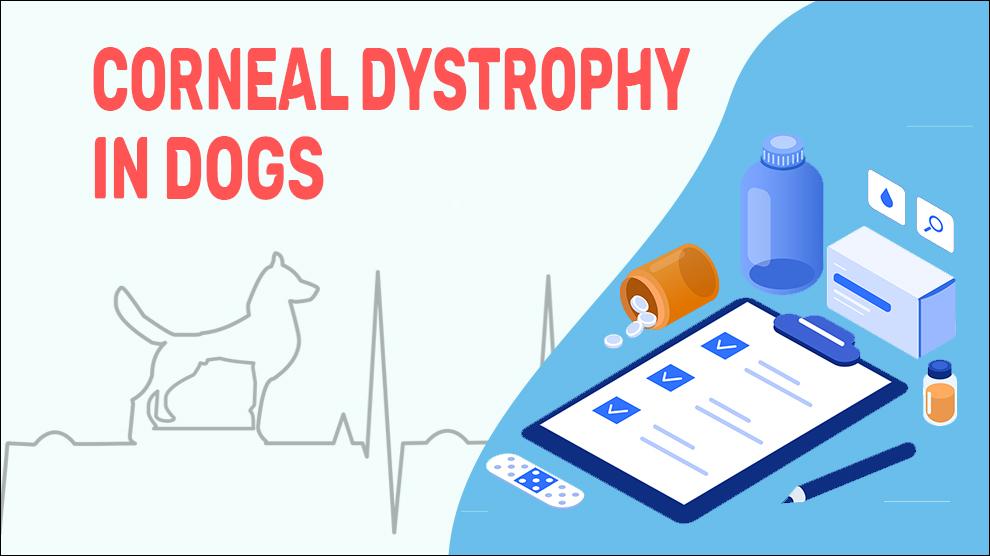Corneal Dystrophy (abnormal form or structures) is inherited, non-inflammatory, progressive deterioration in the function and structure of the cornea - the front, clear layer of the eye.
Corneal degeneration and corneal dystrophy are diseases of the cornea characterized by opacification of white, opaque mineral deposits (triglyceride, cholesterol, or calcium) within the connective tissue of the cornea. Bluish-white or grayish, metallic-looking or crystalline cloudiness is often the first sign of corneal dystrophy.
Continuous sloughing of the mineral deposits can lead to corneal ulcers, corneal scarring, ocular infections, and vascularization. Severe cases of Corneal Dystrophy can lead to visual impairment.
Corneal dystrophy can affect one or both eyes and may occur in areas of the cornea that have suffered a chronic disease process or traumatic incident. It is not an unusual finding at the center of the cornea in older dogs.
Symptoms Of Corneal Dystrophy
- Bluish white or grayish cloud in the center of the eye.
- Round, oval or donut-shaped lesions in the center of the cornea.
- Irritated eyes/pawing at the eyes.
Treatment Options For Corneal Dystrophy
- No treatment is necessary until the lesions are stable. When vision is getting impaired or the pupil is obstructed or any other secondary complications are observed, step-wise medical intervention is required.
- Surgical options: This is recommended for severe cases of corneal dystrophy to remove the mineral deposits.
- If required, anti-inflammatory medications, Antibiotics, and Pain Control Medications such as NSAIDs will be used to control infection and inflammation.
Home Remedies For Corneal Dystrophy
- When your dog is diagnosed with corneal dystrophy, ensure to follow precisely your vet’s medication instructions.
- Regularly monitor the symptoms and contact your vet if you note any significant new symptoms or changes in their vision.
Prevention Of Corneal Dystrophy
Prevention of corneal dystrophy is a hereditary concern. Dogs with dystrophy including First degree relatives (littermates and parents) should not be bred so as to avoid passing the condition on to the next generation.
However, there is currently no certification available with breeders to establish dogs in their breeding program that do not possess the inherited gene. Another important problem is some dogs do not develop the condition until later in life, so it can be complicated to eliminate them from a breeding program before they have been bred many times.
Affected Breeds Of Corneal Dystrophy
Cocker Spaniel, Poodle, Samoyed, Siberian Husky, Pointer, German Shepherd, Bichon Frise, Airedale Terrier, Boston Terrier, Chihuahua, Dachshund
Additional Facts For Corneal Dystrophy
- Risk Factors:
- Hereditary
- High calcium blood levels
- High cholesterol blood levels
- Types:
- Epithelial Corneal Dystrophy: This is associated with abnormality of the outer (upper) epithelial surface of the cornea.
- Stromal Corneal Dystrophy: Also called macular corneal dystrophy, this is caused by fat deposits within the middle-stromal layer of the cornea.
- Endothelial Corneal Dystrophy: Similar to Fuchs endothelial corneal dystrophy in humans, this results in a degenerative change of the deepest (lowest) endothelial layer of the cornea.
- Mortality:
There is no mortality associated with corneal dystrophy documented yet.
- Diagnosis:
- Serum biochemistry profile and complete blood count.
- Tonometry, slit lamp, and fundoscopy.
- Inner eye gonioscopy
- Biomicroscope
- Conjunctival cytology or biopsy
- Intraocular pressure testing
- Corneal stain testing
- Prognosis:
Prognosis often depends on the type and severity of corneal dystrophy. This is often positive with early diagnosis and appropriate treatment. The outcome of acute corneal dystrophy treatment is excellent. The secondary eye issues that the corneal dystrophy may cause should not be ignored as it is often a matter of concern than the actual eye issue.
When To See A Vet
Contact your vet right away, if you notice any of the following:
- Bluish white or grayish cloud in the center of the eye.
Food Suggestions For Corneal Dystrophy
A high-fiber, Low-fat diet is recommended.
On a dry matter basis, Fat should be less than 10% (kibble).
The diet should be included foods containing vitamins A, C, omega 3s, zinc, carotenoids, beta-carotene, lycopene, and antioxidants.
- Omega-3 oily fishes such as salmon, tuna, cod, etc.
- Leafy greens such as spinach, kale, watercress, etc.
- Nonmeat/plant protein sources such as nuts, Lentils, Beans, Eggs, etc.
- Citrus fruits or juices, Sweet potatoes, tomatoes, pumpkin.
- Zinc foods such as Pork, tuna, and Oysters.
- Blueberries, Broccoli, Cabbage, Carrots, etc.
Conclusion
As most lesions in the cornea of affected dogs are benign, they do not require treatment or monitoring over time. The Prognosis is also excellent. Monthly check-ups are recommended and intraocular pressure has to be closely monitored. Eye medications have to be administered according to the vet’s instructions.

















